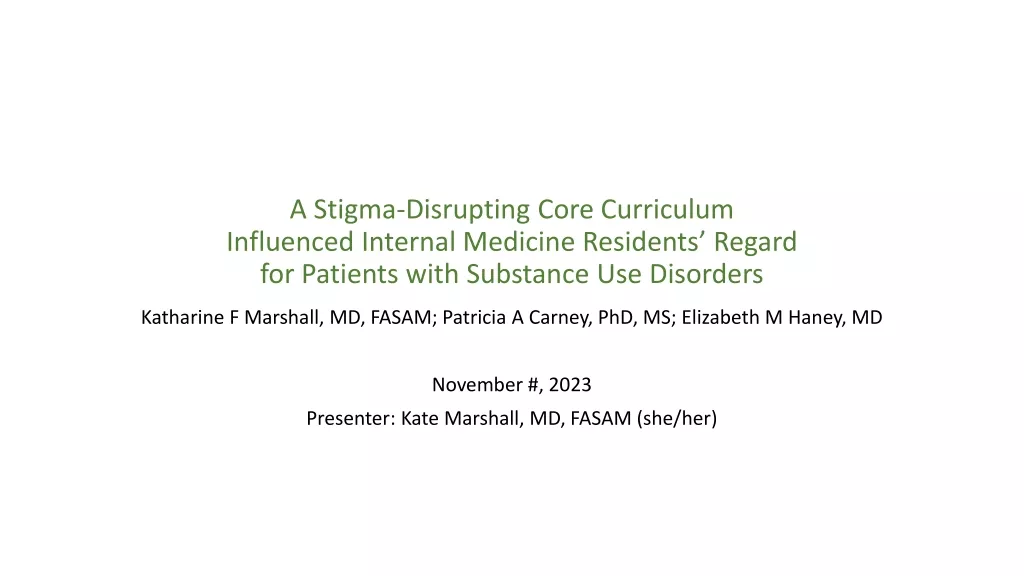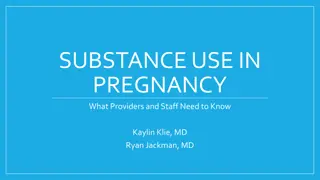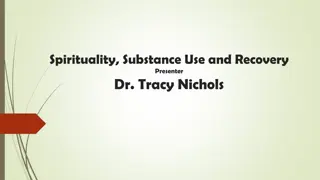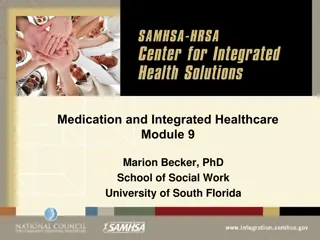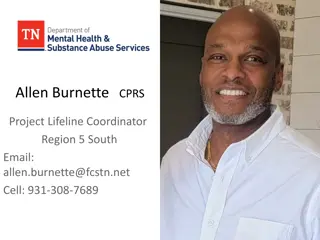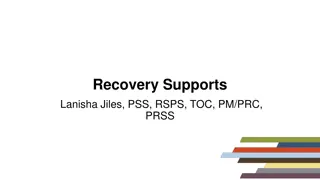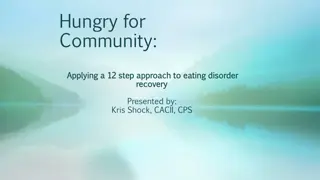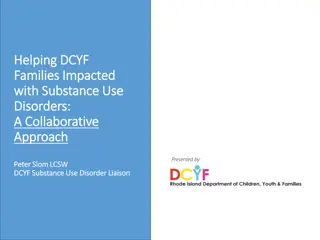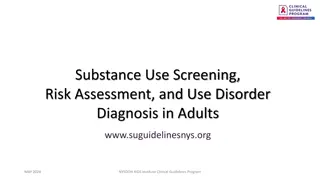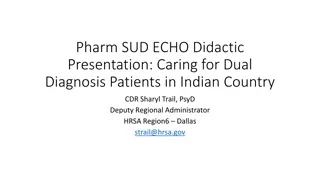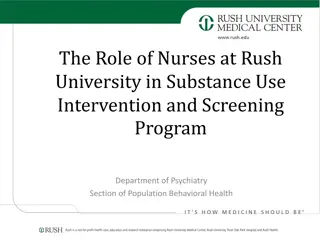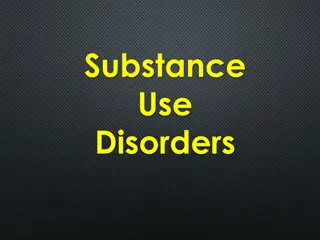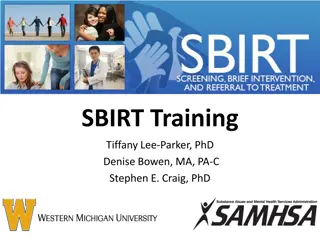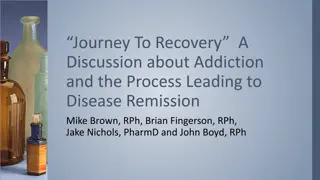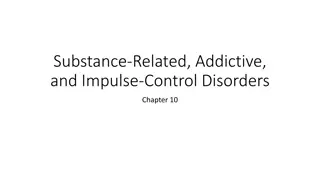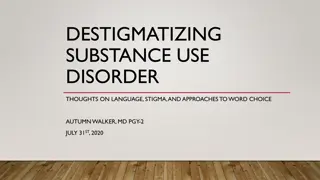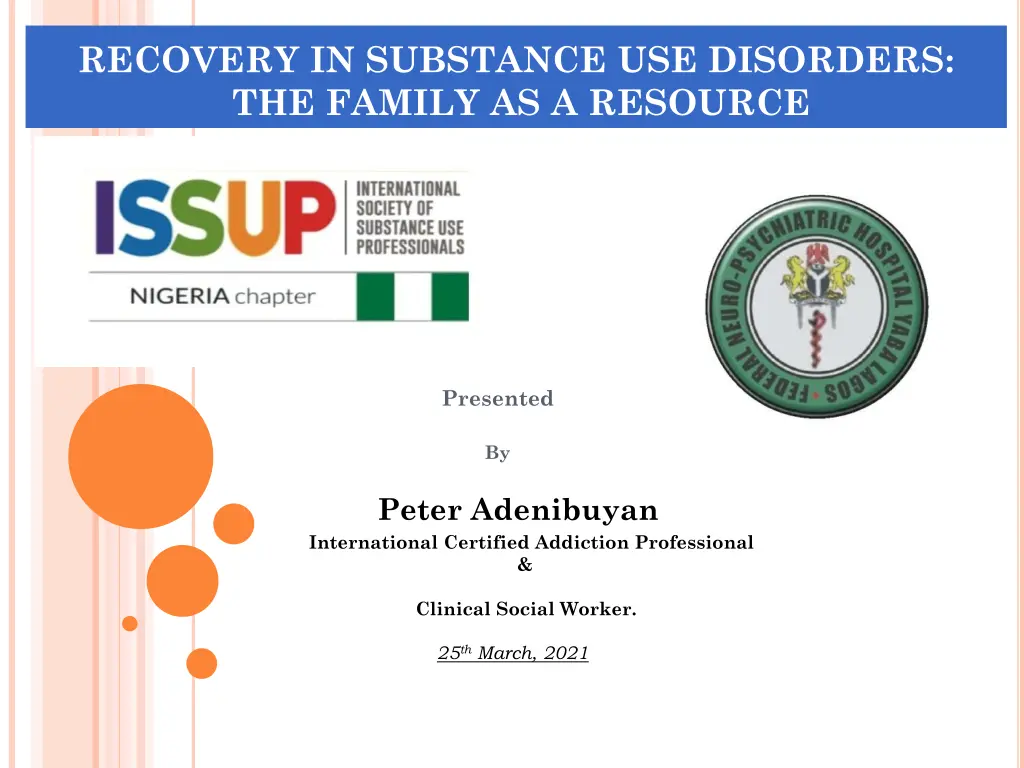
Understanding Recovery Capital: Family, Community, and Personal Resources
Explore the concept of recovery capital in substance use disorders, focusing on personal, family, and community resources. Learn about the domains of recovery management, types of recovery capital, and strategies for relapse prevention. Presented by Peter Adenibuyan, an International Certified Addiction Professional & Clinical Social Worker.
Uploaded on | 0 Views
Download Presentation

Please find below an Image/Link to download the presentation.
The content on the website is provided AS IS for your information and personal use only. It may not be sold, licensed, or shared on other websites without obtaining consent from the author. If you encounter any issues during the download, it is possible that the publisher has removed the file from their server.
You are allowed to download the files provided on this website for personal or commercial use, subject to the condition that they are used lawfully. All files are the property of their respective owners.
The content on the website is provided AS IS for your information and personal use only. It may not be sold, licensed, or shared on other websites without obtaining consent from the author.
E N D
Presentation Transcript
RECOVERY IN SUBSTANCE USE DISORDERS: THE FAMILY AS A RESOURCE Presented By Peter Adenibuyan International Certified Addiction Professional & Clinical Social Worker. 25thMarch, 2021
LEARNING OUTCOMES: Learn about recovery capital for relapse prevention. Learn how to offer an inclusive programme involving families. Identify barriers and facilitators to recovery and leveraging on them. Learn how to handle affiliate stigma issues.
DEFINITION OF TERMS: What is Psychoactive Substance?..is a chemical substance that changes nervous system function and results in alterations in perception, mood, consciousness, cognition or behavior. Substance Use Misuse: Abuse: Dependency: Substance Addiction: a chronic, relapsing brain diseases characterized by compulsive drug seeking and use, despite harmful consequences. Chronic disease: is a long lasting and that cannot be cured but can be managed What is Lapse or slip: a brief, often one time, return to drug. What is relapse ? A complete return to using psychoactive substances in the same way the person did before he or she quit.
WHAT IS RECOVERY AND RECOVERY CAPITAL ?: Recovery from alcohol and drug problems is a process of change through which an individual achieves abstinence and improved health, wellness, and quality of life. Recovery Capital: Is the sum personal and social resources at ones disposal for addressing drug dependency and chiefly, bolstering one s capacity and opportunities for recovery. The quality and quantity of a person s recovery capital played a major role in determining the success or failure of treatment and recovery.
UNODC IDENTIFIED 8 DOMAIN OF RECOVERY MGT:. Physical and Mental Health Family, Social support and leisure activities Safe housing and healthy environment Peer based support Employment and legal resolution Vocational skills and educational development Community integration and cultural support Rediscovering the meaning and purpose in life.
3 TYPES OF RECOVERY CAPITAL THAT AIDS RECOVERY: 1. PERSONAL 2. FAMILY AND SOCIAL 3. COMMUNITY AND CULTURAL Personal: Physical Recovery Capital Human Recovery Capital Physical health Educational and Vocational skill Financial Assets Employability, Values, Safe and Recovery-Conducive Shelter and Environment Perception of the past, present and future in the right perspective Employment , Clothing , Food Problem solving capacities Access to transportation. Self efficacy(a client s self-confidence in managing high risk situation)
FAMILY AND SOCIAL RECOVERY CAPITAL: Family generally refers to persons who are biological and or psychological related with historical, emotional or economic bonds and perceive themselves as part of a household. Family is a unit of every society and a system-what ever affects one family member affects other family members. Substance use can affect other non-substance using family members and lead to dysfunction. On the other hand, family dysfunction can lead to substance use problems in one or more members of the family.
FAMILY AND SOCIAL RECOVERY CAPITAL: The willingness of intimate partner and family members to participate in treatment. The presence of others in recovery within the family or among social contacts. Connections and access to conventional institutions, such as school, a workplace, a place of worship and community organizations. Access to opportunities for recovery-based or at least abstinent based fellowship and leisure activities.
COMMUNITY AND CULTURAL RECOVERY CAPITAL: Active efforts to reduce stigma A full continuum of addiction treatment services. Availability of treatment associations recovery homes, and recovery ministries. Recovery mutual aid and support resource that are accessible e.g. 12 steps. Sources of sustained recovery support and early re- intervention through after care programmes.
FAMILY INVOLVEMENT IN RECOVERY: Family involvement in SUD treatment is positively associated with increased treatment engagement, decreased dropout rates during treatment, and better long term outcomes. When families are involved in treatment the focus can be on the larger family issues, not just the substance use. Both the individual with the SUD and the family members get the help they need to achieve and maintain abstinence. Family approach capitalise on family strength, mobilizing ongoing support for the client s and the family s recovery
WHY DO WE NEED FAMILY IN TREATMENT: Increase family support for the client s recovery. Prepare the family to what to expect in early recovery not to have unrealistic expectations. Educate the family about relapse warning signs and in turn help prevent a relapse. Identify and support a change of family ways that works against recovery e.g. family conflict, enabling behaviour. Enable family to see the need to make the necessary changes in their lives and take responsibility for their emotional, physical and spiritual recovery. Help family to understand and change their dysfunctional behaviour patterns.
INCLUSIVE PROGRAMME INVOLVING FAMILIES: Family based services ensure that family functioning adjust to and positively influences the recovery of the client Brief strategic family therapy (BSFT) Adolescents Multidimensional family therapy (MDFT) for Adolescents Multi systemic Therapy (MST) for Adolescents Behavioral Couple Therapy(BCT) for Couple Parents, Patients and Therapists Forum (PPTF) for Adolescents and Adults.
INCLUSIVE PROGRAMME INVOLVING FAMILIES. In 2009, P.P.T.F. was formed with the purpose to bring together mental health providers, and mental health consumer to interact on the possible: Prevention Causes, Relapse prevention and Treatment Recovery modalities that will be of benefits to all in relapse prevention.
PARENTS, PATIENTS AND THERAPIST FORUM PATIENTS Psycho education Support Group Counseling PARENTS THERAPISTS
PARENTS, PATIENTS AND THERAPISTS FORUM: This focuses on Parents (families of clients include spouse and other sibling or half siblings)Patients (Clients) and Therapists( Doctor Psychologist, Counselor) etc Focuses on providing a supportive environment for families to interact and discuss common concerns and problems PPTF provides psycho-education sessions, focusing on educating family members about addiction, its impact on family, recovery and relapse. In a non-threatening environment the members of the family understand the problem of addiction and learn coping strategies from observing other in a similar situation.
SPECIFIC TOPICS FOR FAMILY(P.P.T.F) How SUD affects the whole family Methods to rebuild relationship and develop trust Re-defining family roles and rules Kind of support the family can provide towards recovery Strengthening communication Promoting self care
P.P.T.F.OUTCOMES: Willingness of intimate partners and family members to participate in treatment Medication adherence Reduction of waiting time during clinic Keeping to follow up program Reduction of stigma Full continuum of addiction treatment services Psycho-education to find out if there are urgent needs.
BARRIERS AND FACILITATORS TO RECOVERY: Marital separation, fear of violence, employment and Child care Family viewed SUDs as a medical problem and involvement of family is not necessary. Family do not believe that treatment can work Family participation in treatment is often wrongly interpreted by family members as being blamed for the SUD problem Social stigma and shame related to it. Sudden death or severe illness of a parent.
BARRIERS AND FACILITATORS TO RECOVERY: Limited personnel who have evidence based knowledge on SUDs prevention and treatment Insufficient capacity in hospitals to treat SUD cases Inadequate funding for training of personnel and lack of funding for SUDs treatment for motivated client. Lack of continuity in treatment services: continuum of care . Lack of mental health services to provide integrated services to handle co-occurring issues. Transportation is a big issues in rural areas, especially right now with the gas prices continue to rise.
HOW TO HANDLE AFFILIATE STIGMA ISSUES: Drug use is a highly stigmatized behaviour, as it is mainly viewed as a controllable behaviour or weakness of character rather as a disease. Stigma is defined as a mark of disgrace devaluation that sets an individual and family apart from others, it comes with guilt, helplessness, anger, sadness, frustration, isolation, anxiety, worry, shame, stress and believing that they have no future. Stigma is sometimes described as an imaginary stain that we see on human being. The term affiliate stigma refers to the internalization of associative stigma by family members. This is not self stigma which applies to individual internalizing a primary stigma or the public stigma felt by families.
HOW TO HANDLE AFFILIATE STIGMA ISSUES: Corrigan and Colleagues (2006) reported that families of drug dependent individual were the most stigmatized and harshly judged, blameworthy for the onset of the disorder, for relapse into drug use and contaminated by their family member s drug use. There is evidence that family members of individual with chronic conditions internalize family stigma in the same way that individual oftentimes internalize public stigma. Family could still be struggling with difficulties related to extreme stress, anxiety, distrust, deteriorating relationships, feelings of powerlessness and Codependency SPEAK OUT: As you learn more about addiction, treatment, and recovery, you are more likely to notice misinformation and adverse effects of stigma. Speak out, challenge inaccuracies, educate others and guide them to authoritative source of information. Don t be quiet.
HOW TO HANDLE AFFILIATE STIGMA ISSUES: Don t define people by their disorder: People are more than their health problems. Addiction does not describe what a person is, addiction describes what a person has. Defining people exclusively by their addiction diminishes the wholeness of their lives, don t say the addict rather say people with addiction. Don t sensationalize addiction: although the consequences of addiction are often dramatic, describing addiction in sensational terms diminishes the fact that addiction is a treatable disease. Don t say suffer from , afflicted with , victims of addiction rather, say he has a substance use disorder , people with addiction .
HOW TO HANDLE AFFILIATE STIGMA ISSUES: Educate the general public that recovery is a dynamic and multiple-phase process in which success is measured through improvement in multiple biopsychosocial domaine,and that these improvement are often incremental. Emphasize that relapse does not represent treatment failure. It doesn t mean that a client has failed or the treatment programme has failed to provide treatment. Rather relapses considered an opportunity to examine an individual's recovery programme and areas where it needs to be strengthened.
IN CONCLUSION In conclusion, the role of family in recovery of SUDs can not be overemphasized. For better prevention, treatment and recovery of an individual with SUDs the family involvement in treatment enhances better treatment outcome. If we all join our hands together the families of people who use substance will be free of affiliate stigma and curb the menace of substance use disorders in our society.
REFERENCES: Corrigan,P.W.(2004). Target-specific stigma change: A strategy for impacting mental illness stigma. Psychiatric Rehabilitation Journal. Curriculum 14: Working with Families with Substance Use Disorder.International Centre for certification and Education, Colombo Plan,2015 Curriculum 4: Basic Counselling skills for Addiction Professionals,, International Centre for certification and Education, Colombo Plan,2015. Olivia Marshall (2013). Associative stigma among families of alcohol and other drug users.

